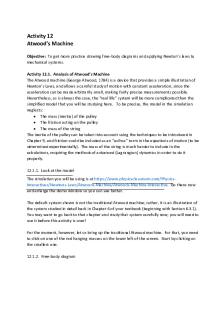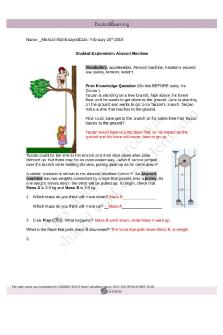Lab( The Atwood Machine ) PDF

| Title | Lab( The Atwood Machine ) |
|---|---|
| Author | shahinur islam |
| Course | Physics II |
| Institution | Borough of Manhattan Community College |
| Pages | 7 |
| File Size | 228.5 KB |
| File Type | |
| Total Downloads | 74 |
| Total Views | 146 |
Summary
Download Lab( The Atwood Machine ) PDF
Description
Islam 1 Name: Professor: Class: Physics 215 Date: 10/03/2020. Newton’s Second Law: The Atwood Machine Introduction: Newton’s second law expresses that the acceleration is directly proportional to the vector sums of forces. However, the net force is inversely proportional with the mass. Furthermore, acceleration and the force will affect the direction of the vector, but the mass won’t affect the direction. Therefore, Newton’s Second Law equation is: F=m a. The Atwood Machine will helps identify the acceleration when we include the two masses that are connected by the string pulley. Then, one of the masses will remain constant while the other mass will keep increasing because we want to examine the acceleration since it depends on the net force and mass. Objectives: Our objective is to state how the acceleration changes within net force while one of the masses keeps increasing and one of them remains constant. Furthermore, is to have an acknowledgment about the Newton’s second law equation. Last, is show how the acceleration can be done experimentally with an Atwood machine. ▪
Procedure:
♦ Varying the Total Mass (Net Force Constant): 1. First, we set up the Atwood Machine. Then we are going to use enough string so that the height is kind of less than 1m.
Islam 2 2. Then, we are going to add 10g on the descending mass, m2, and measure the time it travels from the top to the ground. This is Trial 1 column. 3. We are going to make three independent measurements of the time of m2 to travel from rest to final. 4. Next, we are going to add 100g to each hanger along with 10g that was added in m2 at the beginning of the experiment. This is Trial 2 column. Also, we must take measurement of m2 as we keep adding 100g. 5. We are going to keep repeating step 3 and 4 until Trial 4 column ▪
Varying the unbalanced force (total mass constant):
6. We are going to begin putting 260g on the ascending mass, m1(50g hanger + 200 + 5 +2 + 2 + 1g masses). Then, we are going to add 260g on the descending mass m2 but this will be 50g hanger + 200 + 10g masses. 7.We are going to make three measurements of time for each trial. 8. Next, we are going to transfer 1g from the m1 to m2 in order to create an unbalanced force without disturbing the total mass for Trial 5. 9.Later, we are going to transfer 2g from m1 to m2 for Trial 6. a. Another transfer of 2g for Trial 7. b. Finally, a transfer of 5g for Trial 8. ❖ Comments on Experimental Technique: 1.Hold m1 down against the floor and at the same time release and start timing. 2.Then, stop the timer when m2 reaches the floor.
Islam 3 Data set: Data Table 1: F is constant
Descending mas m2(g) Ascending mass m1(g) Distance Yard y (m) Times of travel Run 1 Run 2 t (s) Run 3 Average Measure acceleration
Trial 1 64.61g 54.16g 1.13m 1.69s 1.67s 1.68s 1.68s 0.80 m/s2
Trial 2 164.61g 154.16 1.12m 2.69s 2.71s 2.70s 2.70s 0.31 m/s2
Trial 3 264.61g 254.16g 1.12m 3.60s 3.59s 3.61s 3.60s 0.17 m/s2
Trial 4 364.61g 354.16g 1.11m 3.79s 3.81s 3.80s 3.80s 0.15 m/s2
118.77g
318.77g
518.77g
718.77g
102.51 N
102.51 N
102.51 N
102.51 N
0.90m/s2
0.32m/s2
0.20m/s2
0.14m/s2
12%
3%
16%
7%
am= 2y/t2(m/s2) Total mass m1 + m2 Net Force (m2 - m1) g (N) Theoretical acceleration at= (net force)/ total mass Percent different between am and at
Data Table 2: m is constant
Descending mas m2 (g) Ascending mass m1 (g) Distance Yard y (m) Time of travel Run 1 t (s) Run 2 Run 3 Average
Trial 5 265.61g 263.16g 1.12m -
Trial 6 267.61g 261.16g 1.12m 4.31s 4.33s 4.35s 4.33s
Trial 7 269.61g 259.16g 1.12m 3.35s 3.40s 3.30s 3.35s
Trial 8 274.61g 254.16g 1.12m 2.72s 2.69s 2.72s 2.71s
Measure acceleration
-
0.12m/s2
0.20m/s2
0.31m/s2
-
528.77g
528.77g
528.77g
am= 2 y/t2(m/s2) Total mass m1+ m2
Islam 4 Net Force
-
63.27N
102.51N
200.61N
-
0.12m/s2
0.19m/s2
0.38m/s2
-
0%
5.1%
20%
(m2 - m1) g (N) Theoretical acceleration at= net force / total mass Percent difference between am and at
Calculations: Data Table 1 Measured acceleration: am = 2y / t2 Trial 1: 2(1.13m)/ (1.68s) ^2 = 0.80m/s2 Trial 2: 2(1.12m)/ (2.70s) ^2 = 0.31m/s 2 Trial 3: 2(1.12m)/ (3.60s) ^2 = 0.17m/s 2 Trial 4: 2(1.11m)/ (3.80s) ^2 = 0.15m/s 2 Total Mass: m1 + m2 Trial 1: 64.61g + 54.16g = 118.77g Trial 2: 164.61g + 154.16g = 318.77g Trial 3: 264.61g + 254.16g = 518.77g Trial 4: 364.61g + 354.16g = 718.77g Net Force: (m2 - m1) (g) N Trial 1: (64.61g - 54.16g) (9.81m/s2) = 102.51N Trial 2: (164.61g - 154.16g) (9.81m/s2) = 102.51N Trial 3: (264.61g - 254.16g) (9.81m/s2) = 102.51N Trial 4: (364.61g - 354.16g) (9.81m/s2) = 102.51N
Islam 5 Theoretical Force: at = net force / total mass Trial 1: 102.51 N / 118.77 g = 0.90m/s2 Trial 2: 102.51 N / 318.77 g = 0.32m/s2 Trial 3: 102.51 N / 518.77 g = 0.20m/s2 Trial 4: 102.51 N / 718.77 g = 0.14m/s 2
Percent Difference: (| am – at | / (am + at) / 2) *100 Trial 1: (|0.80 –0.90| / (0.80 + 0.90) / 2) *100 = 12% Trial 2: (|0.31 – 0.32| / (0.31 + 0.32) / 2) *100 = 3% Trial 3: (|0.17 – 0.20| / (0.17 + 0.20) / 2) *100 = 16% Trial 4: (|0.15 – 0.14| / (0.15 + 0.14) / 2) *100 = 7% Conclusion: In conclusion, we can see that when the mass was increasing the acceleration was decreasing. However, when we kept the total mass constant the acceleration kept increasing. Therefore, the formula of the second law of Newton tell us that acceleration is directly proportion with force, so when the force is increasing the acceleration is increasing; but mass is inversely proportional so acceleration will decrease.
Lab Questions and answer: 1. In the experiment, should the mass of the string be added to the total mass moved by the unbalanced force for better accuracy? Explain.
Islam 6 Ans: For more batter accuracy the answer is yes because here acceleration is found from total mass which is from m1 and m2. 2. Complete the following sentences: (a) When the unbalanced force increases (total mass remaining constant), the acceleration of the system also increases because force and acceleration have a proportional relation. (b) When the total mass that is accelerating increases (unbalanced force remaining constant), the acceleration of system decreases because of mass is inversely proportional to the acceleration. 3. How can the value of g, the acceleration due to gravity, be determined using an Atwood machine? Ans: In Atwood machine we take two masses Ma and Mb. Now assuming Ma > Mb we will calculate force acting on two bodies and equate it to the net gravitational force acting on the difference in masses of the two bodies. That means (Ma + Mb) *a = g*(Ma - Mb). Here g is acceleration due to gravity. Now by using proper means like photogates, we will calculate acceleration a. Finally, g will be calculated as, g = a*(Ma + Mb) / (Ma - Mb).
Islam 7...
Similar Free PDFs

Lab( The Atwood Machine )
- 7 Pages

Lab 4 - the atwood machine
- 9 Pages

The Atwood Machine - lab report
- 2 Pages

Atwood Machine - Lab report.
- 2 Pages

Atwood LAB
- 5 Pages

atwood lab- lab report
- 4 Pages

Lab Report 2- Atwood Lab
- 6 Pages

Lab 12 - Atwoods Machine
- 6 Pages

LAB Report Lathe Machine
- 13 Pages

Atwood\'s Machine Online Lab
- 4 Pages

Machine Learning LAB Manual
- 66 Pages

Lab Manual Machine Learning
- 27 Pages

The Time Machine
- 8 Pages

The Tolman Eichenbaum Machine
- 39 Pages
Popular Institutions
- Tinajero National High School - Annex
- Politeknik Caltex Riau
- Yokohama City University
- SGT University
- University of Al-Qadisiyah
- Divine Word College of Vigan
- Techniek College Rotterdam
- Universidade de Santiago
- Universiti Teknologi MARA Cawangan Johor Kampus Pasir Gudang
- Poltekkes Kemenkes Yogyakarta
- Baguio City National High School
- Colegio san marcos
- preparatoria uno
- Centro de Bachillerato Tecnológico Industrial y de Servicios No. 107
- Dalian Maritime University
- Quang Trung Secondary School
- Colegio Tecnológico en Informática
- Corporación Regional de Educación Superior
- Grupo CEDVA
- Dar Al Uloom University
- Centro de Estudios Preuniversitarios de la Universidad Nacional de Ingeniería
- 上智大学
- Aakash International School, Nuna Majara
- San Felipe Neri Catholic School
- Kang Chiao International School - New Taipei City
- Misamis Occidental National High School
- Institución Educativa Escuela Normal Juan Ladrilleros
- Kolehiyo ng Pantukan
- Batanes State College
- Instituto Continental
- Sekolah Menengah Kejuruan Kesehatan Kaltara (Tarakan)
- Colegio de La Inmaculada Concepcion - Cebu

